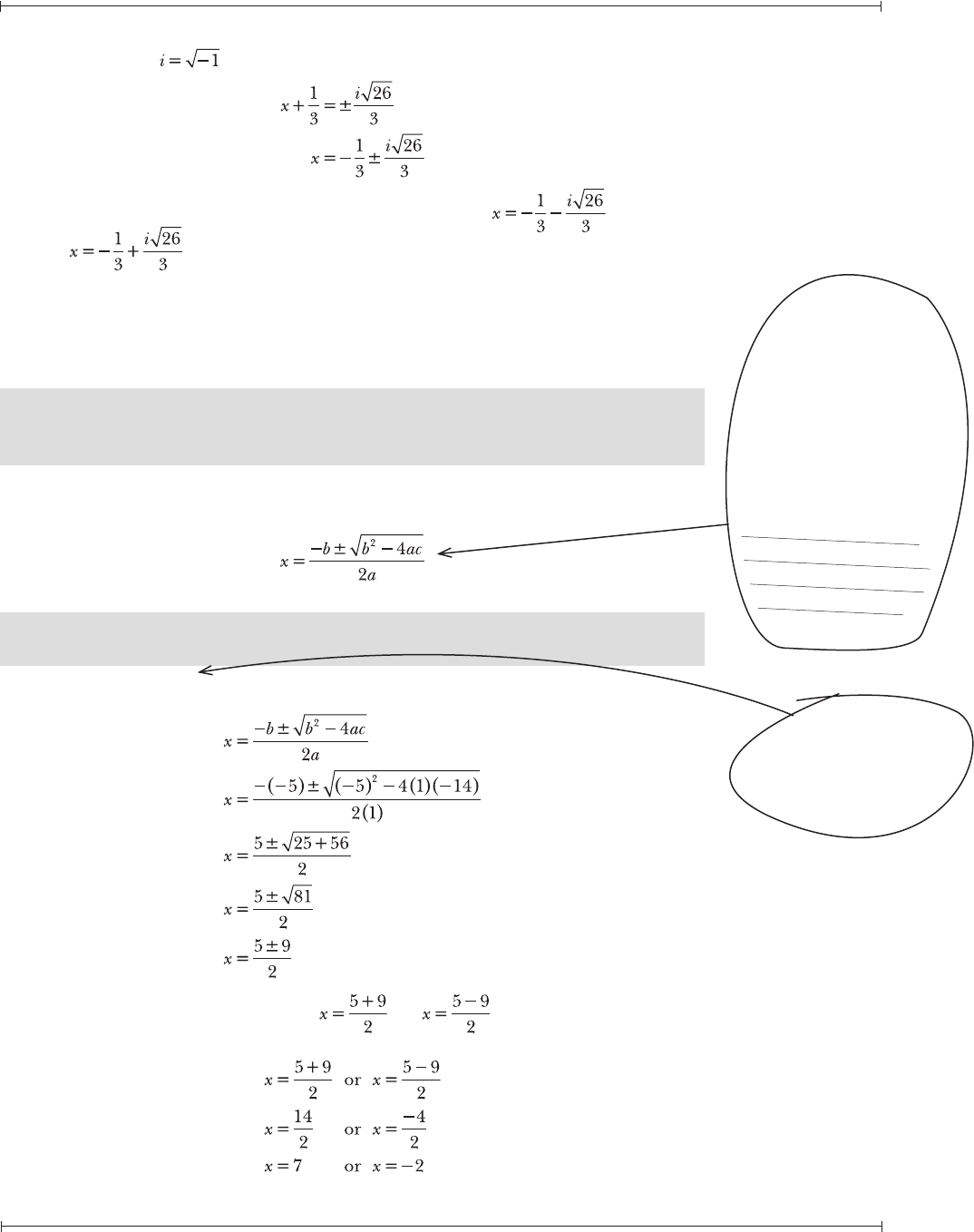
Chapter Fourteen — Quadratic Equations and Inequalities
The Humongous Book of Algebra Problems
305
Recall that .
The solutions to the equation are complex numbers: or
.
Quadratic Formula
Use an equation’s coefcients to calculate the solution
14.20 According to the quadratic formula, what are the solutions to the equation
ax
2
+ bx + c = 0, assuming a ≠ 0?
To solve the equation ax
2
+ bx + c = 0 using the quadratic formula, substitute the
coefficients a, b, and c into the formula below.
14.21 Solve using the quadratic formula: x
2
– 5x – 14 = 0.
Substitute a = 1, b = –5, and c = –14 into the quadratic formula.
The solution to the equation is or . Simplify the rational
expressions.
The solution to the equation x
2
– 5x – 14 = 0 is x = –2 or x = 7.
This is
the quadratic
formula. Make
sure to memorize
it. If the equation is
equal to 0, then a is
the coefcient of x
2
, b
is the coefcient of x,
and c is the constant.
Make sure that one
side of the equation
equals 0 before you
use the formula!
If x
2
or
x doesn’t have a
coefcient written
in front of it, the
coefcient is 1.

Chapter Fourteen — Quadratic Equations and Inequalities
The Humongous Book of Algebra Problems
306
14.22 Solve using the quadratic formula: 2x
2
– 7x + 3 = 0.
Substitute a = 2, b = –7, and c = 3 into the quadratic formula.
The solution to the equation is or x = 3.
14.23 Solve using the quadratic formula: –5x
2
+ x + 8 = 0
Substitute a = –5, b = 1, and c = 8 into the quadratic formula.
You can’t
simplify this
radical. The
only factors of 161
(besides the obvious
factors 1 and 161)
are 7 and 23, and
neither of those
are perfect
squares.

Chapter Fourteen — Quadratic Equations and Inequalities
The Humongous Book of Algebra Problems
307
The solution is or .
14.24 Solve using the quadratic formula: x
2
+ 2 = –8x.
To apply the quadratic formula, one side of the equation must equal 0. Add 8x
to both sides of the equation.
x
2
+ 8x + 2 = 0
Substitute a = 1, b = 8, and c = 2 into the quadratic formula.
Reduce the fraction to lowest terms.
The solution is or .
To get
these answers, factor
–1 out of the numerators and
denominators and cancel out –1’s:

Chapter Fourteen — Quadratic Equations and Inequalities
The Humongous Book of Algebra Problems
308
14.25 According to Problem 14.8, the solution to the equation 10x
2
+ 13x – 3 = 0 is
or . Verify the solution using the quadratic formula.
Substitute a = 10, b = 13, and c = –3 into the quadratic formula.
The quadratic formula verifies the solution: or .
14.26 According to Problem 14.19, the solution to the equation 3x
2
+ 2x + 9 = 0 is
or . Verify the solution using the quadratic
formula.
Substitute a = 3, b = 2, and c = 9 into the quadratic formula.
If you
have trouble
factoring, use the
quadratic formula
to solve quadratic
equations. As this
problem demonstrates,
you’ll get the same
answer either
way.

Chapter Fourteen — Quadratic Equations and Inequalities
The Humongous Book of Algebra Problems
309
Reduce the fraction to lowest terms.
The quadratic formula verifies the solution generated by completing the square:
14.27 Generate the quadratic formula by completing the square to solve the
equation ax
2
+ bx + c = 0, assuming a > 0.
To complete the square, the coefficient of x
2
must be 1. Divide each term
of the equation by a.
Subtract the constant from both sides of the equation.
You can
make the
x
2
-term of any
quadratic equation
positive, so this is a
pretty reasonable
assumption. If the
x
2
-coefcient is
negative, just
divide all of the
terms by –1.
0 divided by any
nonzero number
equals 0.
Even though c and
a look like variables,
they’re constants.
The coefcients of a
quadratic equation (a,
b, and c) don’t suddenly
change in the middle of
a problem—you don’t know
what those coefcients
are, so you use a, b,
and c to represent
them.
..................Content has been hidden....................
You can't read the all page of ebook, please click here login for view all page.
